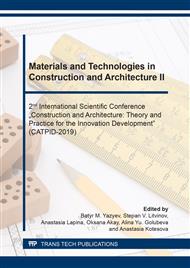[1]
Russian standard GOST 30744-2001 Cements. Methods of testing with using polyfraction standard sand. Moscow: Russian Gosstroi. GUP CPP. 2011. (In Russian).
Google Scholar
[2]
Russian standard GOST 22688-77 Lime for building purposes. Test methods. Moscow: IPK The Standards Publishing House. 1997. (In Russian).
Google Scholar
[3]
Russian standard GOST 23789-79 ST SEV 826-77). Gypsum binders. Test methods. Moscow: Izdatelstvo satandartov. 1987. (In Russian).
Google Scholar
[4]
J. Shekhovtsova, I. Zhernovsky, M. Kovtun, N. Kozhukhova, I. Zhernovskaya, E. P. Kearsley, Estimation of fly ash reactivity for use in alkali-activated cements – a step towards sustainable building material and waste utilization, Journal of Cleaner Production. 178 (2018) 22-33.
DOI: 10.1016/j.jclepro.2017.12.270
Google Scholar
[5]
J. Shekhovtsova, I.V. Zhernovsky, N.I. Kozhukhova, M.N. Kovtun, E. Kearsley, I.V. Zhernovskaya, Express-method for determination of compressive strength of geopolymer based on low-calcium fly ash, Bulletin of BSTU named after V.G. Shukhov. 8 (2018) 28-35. (In Russian).
DOI: 10.12737/article_5b6d58466ede22.04375827
Google Scholar
[6]
N. Kozhukhova, I. Zhernovsky, K. Sobolev, The effect of silica polymerization in fly ash on the strength of geopolymers, Journal of the Society for American Music. 2 (2014) 1611.
DOI: 10.1557/opl.2014.760
Google Scholar
[7]
N.I. Alfimova, N.N. Shapovalov, E.E. Shadskii, T.G. Yurakova, Efficiency upgrading of using of volcanic materials, Bulletin of BSTU named after V.G. Shukhov. 5 (2015) 11-15. (In Russian).
Google Scholar
[8]
R.V. Lesovik, N.I. Alfimova, M.N. Kovtun, A.N. Lastovetsky, About of workability of technogenic sands as raw materials for construction materials, Regional architecture and construction. 2 (2008) 10-15.
Google Scholar
[9]
V.A. Doroganov, N.A. Peretokina, E.A. Doroganov, E.I. Evtushenko, O.Y. Danilova, Study of Nano-Differentiated Silicon Carbide Binders and Composites Based on Them, Refractories and Industrial Ceramics. 55 (5) (2015) 465-468.
DOI: 10.1007/s11148-015-9745-0
Google Scholar
[10]
[V.A. Doroganov, E.I. Evtushenko, Yu.E. Pivinskii, Plastic molding refractory mixes based on highly concentrated ceramic binding suspensions of high alumina fireclay, Refractories and Industrial Ceramics. 48 (1) (2007) 63-68.
DOI: 10.1007/s11148-007-0028-2
Google Scholar
[11]
M. Criado, A. Fernandez-Jimenez, A. Palomo Alkali activation of fly ash. Effect of the SiO2/Na2O ratio. Part I. FTIR study, Microporous Mesoporous Materials. 106 (2007) 180-191.
DOI: 10.1016/j.micromeso.2007.02.055
Google Scholar
[12]
V. Promakhov, A. Zhukov, I. Dubkova, I. Zhukov, S. Kovalchuk, T. Zhukova, A. Olisov, V. Klimenko, N. Savkina, Structure and Properties of ZrO2-20%Al2O3 Ceramic Composites Obtained Using Additive Technologies, Materials. 11 (12) (2018) 2361.
DOI: 10.3390/ma11122361
Google Scholar
[13]
A. Fernández-Jiménez, A. De La Torre, A. Palomo, G. López-Olmo, M. M. Alonso, M.A.G. Aranda, Quantitative determination of phases in the alkali activation of fly ash. Part I. Potential ash reactivity, Fuel. 85 (2006) 625-634.
DOI: 10.1016/j.fuel.2006.04.006
Google Scholar
[14]
A. Fernandez-Jimenez, A. Palomo, I. Sobrados, J. Sanz. The role played by the reactive alumina con-tent in the alkaline activation of fly ashes, Microporous Mesoporous Materials. 91 (2006) 111-119.
DOI: 10.1016/j.micromeso.2005.11.015
Google Scholar
[15]
M. Criado, A. Fernandez-Jimenez, A. De La Torre, M.A.G. Aranda, A. Palomo, An XRD study of the effect of the SiO2/Na2O ratio on the alkali activation of fly ash, Cement and Concrete Research. 37 (2007) 671-679.
DOI: 10.1016/j.cemconres.2007.01.013
Google Scholar
[16]
M. Criado, A. Fernandez-Jimenez, A. Palomo, Alkali activation of fly ash. Part III: Effect of curing conditions on reaction and its graphical description, Fuel. 89 (2010) 3185-3492.
DOI: 10.1016/j.fuel.2010.03.051
Google Scholar
[17]
V.D. Glukhovsky, Alkali-activated cements, concrete and structures. Proceeding of 3d All-Union research-to-practice conference. Kiev. 1 (1989) 256.
Google Scholar
[18]
V.F.F. Barbosa, K.J.D. MacKenzie, C. Thaumaturgo, Synthesis and Characterization of Materials Based on Inorganic Polymers of Alumina and Silica: Sodium Polysialate Polymers, International Journal of Inorganic Materials. 2 (4) (2000) 309-317.
DOI: 10.1016/s1466-6049(00)00041-6
Google Scholar
[19]
A. Fernández-Jiménez, A. De La Torre, A. Palomo, G. López-Olmo, M.M. Alonso, M.A.G. Aranda, Quantitative determination of phases in the alkaline activation of fly ash. Part II: Degree of reaction. Fuel. 85 (2006) 1960-1969.
DOI: 10.1016/j.fuel.2006.04.006
Google Scholar
[20]
R.T. Cygan, J.-J. Liang, A.G. Kalinichev, Molecular Models of Hydroxide, Oxyhydroxide, and Clay Phases and the Development of a General Force Field, J. Phys. Chem. 108(4) (2004) 1255-1266.
DOI: 10.1021/jp0363287
Google Scholar
[21]
A.A. Appen, Сhemistry of glass. Leningrad, 1974, 352.
Google Scholar
[22]
N.I. Kozhukhova, V.V. Strokova, M.I. Kozhukhova, I.V. Zhernovsky, Structure formation in alkali activated aluminosilicate binding systems using natural raw materials with different crystallinity degree, Construction Materials and Products. 1 (4) (2018) 38-43. (In Russian).
DOI: 10.34031/2618-7183-2018-1-4-38-43
Google Scholar
[23]
N.I. Kozhukhova, V.V. Strokova, M.I. Kozhukhova, R.V. Chizhov, Chemical reactivity assessment method of nanostructured low calcium aluminosilicates, Construction Materials and Products. (2019) Forthcoming. (In Russian).
DOI: 10.34031/2618-7183-2019-2-3-5-11
Google Scholar


